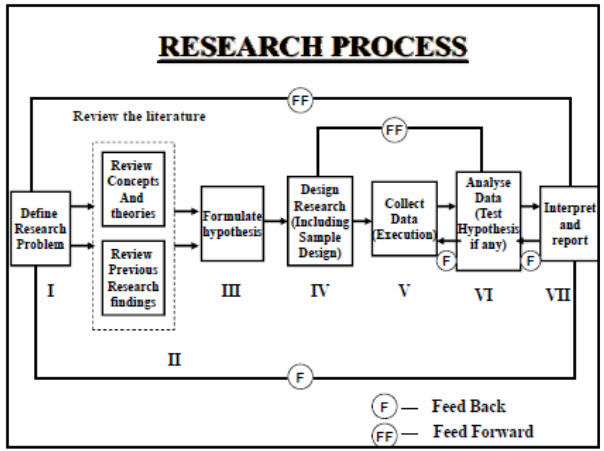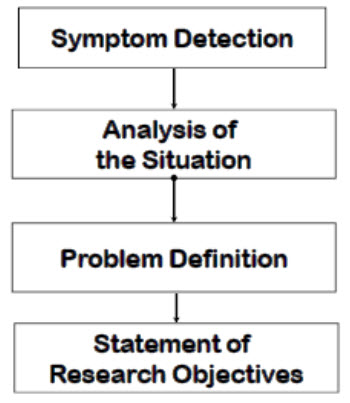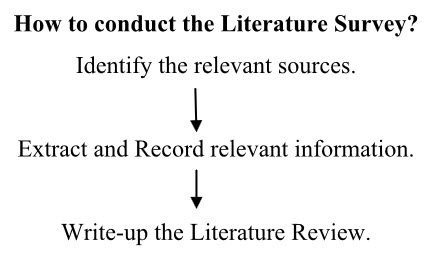About Authors:
Chaudhari Rahul B.
Department of Pharmaceutical Technology,
University Institute of Chemical Technology (UICT),
North Maharashtra University,
Jalgaon - 425 001 (M.S.) India
rahul88chaudhari@gmail.com
Abstract:
Research is a scientific and systematic search for pertinent information on a specific topic. Research is a process of manipulation of things, concepts or symbols for the purpose of generalizing to extend, correct or verify knowledge, whether that knowledge aids in the construction of theory or in the practice of an art. Research Methodology comprises types of research, criteria, objective, and significance of research. The research process various steps, at times, the first step determines the nature of the last step to be undertaken. Here we only discuss about first to three steps they are defining the research problem, review of literature, formulation of hypothesis. This various steps of research process are discussed in brief here.
Reference Id: PHARMATUTOR-ART-1989
Defining Research:
Research refers to a search for knowledge. A scientific and systematic search for pertinent information on a specific topic. In fact, research is an art of scientific investigation. “A careful investigation or inquiry especially through search for new facts in any branch of knowledge.” The Advanced Learner’s Dictionary of Current English “Systematized effort to gain new knowledge” Redman and Mory.[1, 2]
Research is a process of manipulation of things, concepts or symbols for the purpose of generalizing to extend, correct or verify knowledge, whether that knowledge aids in the construction of theory or in the practice of an art” Slesinger and Stephenson in Encyclopaedia of Social Sciences. The search for knowledge through objective and systematic method of finding solution to a problem is “research”.[1, 6]
Research comprises the following:
Defining and redefining the problem Formulating hypothesis collecting, organizing and evaluating data Making deductions and reaching conclusions. Carefully testing the conclusions to determine whether they fit the hypothesis
Types of Research:
- Descriptive
- Analytical
- Applied
- Fundamental
- Quantitative
- Qualitative
- Conceptual
- Empirical
- Other [1]
Defining Research Methodology:
Research methods:
All those methods/techniques that are used for conduction of research. Research methods or techniques, thus, refer to the methods the researchers use in performing research operations.
Research methodology:
It is a way to systematically solve the research problem. It may be understood as a science of studying how research is done scientifically.[1]
Objectives of Research:
1. To gain familiarity with a phenomenon or to achieve new insights into it (studies with this object in view are termed as exploratory or formulative research studies).
2. To portray accurately the characteristics of a particular individual, situation or a group (studies with this object in view are known as descriptive research studies).
3. To determine the frequency with which something occurs or with which it is associated with something else (studies with this object in view are known as diagnostic researchstudies).
4. To test a hypothesis of a causal relationship between variables (such studies are known as hypothesis testing research studies).[1, 2]
Research Process:
The research process comprises of
1. Formulating the research problem
2. Extensive literature survey
3. Developing the hypothesis
4. Preparing the research design
5. Determining sample design
6. Collecting the data
7. Execution of the project
8. Analysis of data
9. Hypothesis testing;
10. Generalizations and interpretation
11. Preparation of the report or presentation of the results, i.e. formal write-up of conclusions reached.[1, 5]
Significance / Relevance of Research:
“All progress is born of inquiry. Doubt is often better than overconfidence, for it leads to inquiry, and inquiry leads to invention” Hudson Increased amounts of research make progress possible. Research inculcates scientific and inductive thinking and it promotes the development of logical habits of thinking and organization. To students who are to write a master’s or Ph.D. thesis, research may mean a careerism or a way to attain a high position in the social structure; To professionals in research methodology, research may mean a source of livelihood; To philosophers and thinkers, research may mean the outlet for new ideas and insights; To literary men and women, research may mean the development of new styles and creative work; To analysts and intellectuals, research may mean the generalizations of new theories.[1, 2]
Criteria of Good Research:
1. Purpose should be clearly defined.
2. Research Process (source of data etc.) should be described in sufficient detail (except when secrecy is required).
3. There is a clear statement of research aims, which defines the research question.[5]
4. Design (Sampling, questionnaire, observation etc) should be thoroughly planned so as to yield objective results.
5. High ethical standards.
6. Limitations should be frankly revealed (e.g. flaws in design) so that the decision maker is made aware.
7. Analysis of data should be adequate and methods of analysis appropriate. Should check for reliabilityand validity, and probability of error
8. Unambiguous presentation
9. Conclusions should be confined to those justified by the data of the research.
A good research is,
- Systematic
- Logical
- Empirical
- Replicable
Research process:

Fig. 1. Research Process
The chart indicates that the research process consists of a number of closely related activities, as shown through I to VII. But such activities overlap continuously rather than following a strictly prescribed sequence. At times, the first step determines the nature of the last step to be undertaken. If subsequent procedures have not been taken into account in the early stages, serious difficulties may arise which may even prevent the completion of the study. One should remember that the various steps involved in a research process are not mutually exclusive; nor are they separate and distinct.
STEP-1
Defining the research problem:
What is a research problem?
The term ‘problem’ means a question or issue to be examined.
Research Problem refers to some difficulty /need which a researcher experiences in the context of either theoretical or practical situation and wants to obtain a solution for the same.
The first step in the research process – definition of the problem involves two activities:
- Identification / Selection of the Problem
- Formulation of the Problem[1, 2, 4]
How do we know we have a research problem?
- Customer complaints
- Conversation with company employees
- Observation of inappropriate behaviour or conditions in the firm
- Deviation from the business plan
- Success of the firm’s competitor’s
- Relevant reading of published material (trends, regulations)
- Company records and reports.
Identification / selection of the research problem:
This step involves identification of a few problems and selection of one out of them, after evaluating the alternatives against certain selection criteria.
Sources of problems:
- Reading
- Academic Experience
- Daily Experience
- Exposure to Field Situations
- Consultations
- Brainstorming
- Research
- Intuition[1]
Definition / formulation of the research problem:
Formulation is the process of refining the research ideas into research questions and objectives. Formulation means translating and transforming the selected research problem/topic/idea into a scientifically researchable question. It is concerned with specifying exactly what the research problem is.
Process involved in defining the problem:
The selection of one appropriate research able problem out of the identified problems requires evaluation of those alternatives against certain criteria. They are:
- Internal / Personal criteria – Researcher’s Interest, Researcher’s Competence, Researcher’s own Resource: finance and time.
- External Criteria or Factors – Research ability of the problem, Importance and Urgency, Novelty of the Problem, Feasibility, Facilities, Usefulness and Social Relevance, Research Personnel.
Problem definition or Problem statement is a clear, precise and succinct statement of the question or issue that is to be investigated with the goal of finding an answer or solution.
There are two ways of stating a problem:
1) Posting question / questions
2) Making declarative statement / statements[1]
Understanding the nature of problem:
- Surveying the available literature
- Understanding the nature of problem
- Surveying the available literature
- Developing ideas through discussions
- Rephrasing the research problem
Defining Problem, Results in Clear Cut Research Objectives.

STEP-2
Review of literature:
Literature Review is the documentation of a comprehensive review of the published and unpublished work from secondary sources of data in the areas of specific interest to the researcher. The main aim is to find out problems that are already investigated and those that need further investigation. It is an extensive survey of all available past studies relevant to the field of investigation. It gives us knowledge about what others have found out in the related field of study and how they have done so.[3]
Purpose of review:
- To gain a background knowledge of the research topic.
- To identify the concepts relating to it, potential relationships between them and to formulate researchable hypothesis.
- To identify appropriate methodology, research design, methods of measuring concepts and techniques of analysis.
- To identify data sources used by other.

Sources of literature:
- Books and Journals
- Electronic Databases
- Bibliographic Databases
- Abstract Databases
- Full-Text Databases
- Govt. and Industry Reports
- Internet
- Research Dissertations / Thesis
How to write the review?
1. There are several ways of presenting the ideas of others within the body of the paper.
2. For Example; If you are referring the majorinfluencing factors in the Sheth’s model of Industrial Buying Behaviour, it can be written as,
1) Sheth (1973, p-50) has suggested that, there are a number of influencing factors ……..
2) According to Sheth (1973) model of industrial buying behaviour.
3) In some models of industrial buying behaviour, there are a number of influencing factors (Sheth, 1973).
4) In some models of industrial buying behaviour, there are a number of influencing factors1. 1. Sheth J.N (1973), A Model of Industrial Buying Behaviour, Journal of Marketing, 37(4), 50-56.
Points to be kept in mind while reviewing literature:
- Read relevant literature.
- Refer original works.
- Read with comprehension.
- Read in time.
- Index the literature.
STEP-3
Formulation of hypothesis:
A hypothesis is an assumption about relations between variables.
- Hypothesis can be defined as a logically conjectured relationship between two or more variables expressed in the form of a testable statement. Relationships are conjectured on the basis of the network of associations established in the theoretical framework formulated for the research study. Research Hypothesis is a predictive statement that relates an independent variable to a dependant variable. Hypothesis must contain at least one independent variable and one dependant variable. Hypothesis is tentative, intelligent guesses as to the solution of the problem.
- Hypothesis is a specific statement of prediction. It describes in concrete terms what you expect to happen in the study.
- Hypothesis is an assumption about the population of the study.
- It delimits the area of research and keeps the researcher on the right track.[7]
Problem (VS) hypothesis:
- Hypothesis is an assumption, that can be tested and can be proved to be right or wrong.
- A problem is a broad question which cannot be directly tested. A problem can be scientifically investigated after converting it into a form of hypothesis.
Characteristics of hypothesis:
1. Conceptual Clarity - It should be clear and precise.
2. Specificity - It should be specific and limited in scope.
3. Consistency - It should be consistent with the objectives of research.
4. Testability - It should be capable of being tested.
5. Expectancy - It should state the expected relationships between variables.
Characteristics of hypothesis:
- Simplicity - It should be stated as far as possible in simple terms.
- Objectivity - It should not include value judgments, relative terms or any moral preaching.
- Theoretical Relevance - It should be consistent with a substantial body of established or known facts or existing theory.
- Availability of Techniques – Statistical methods should be available for testing the proposed hypothesis.
Sources of hypothesis:
- Discussions with colleagues and experts about the problem, its origin and objectives in seeking a solution.
- Examination of data and records for possible trends, peculiarities.
- Review of similar studies.
- Exploratory personal investigation / Observation.
- Logical deduction from the existing theory.
- Continuity of research.
- Intuition and personal experience.[8]
Types of hypothesis:
1. Descriptive Hypothesis:
These are assumptions that describe the characteristics (such as size, form or distribution) of a variable. The variable may be an object, person, organisation, situation or event.
Examples:“Public enterprises are more amenable for centralized planning”.
2. Relational Hypothesis [Explanatory Hypothesis]:
These are assumptions that describe the relationship between two variables. The relationship suggested may be positive, negative or causal relationship.
Examples:
“Families with higher incomes spend more for recreation”. Causal Hypothesis state that the existence of or change in one variable causes or leads to an effect on another variable. The first variable is called the independent variable and the latter is the dependant variable.
3. Null Hypothesis:
When a hypothesis is stated negatively, it is called null hypothesis. It is a ‘no difference’, ‘no relationship’ hypothesis. ie., It states that, no difference exists between the parameter and statistic being compared to or no relationship exists between the variables being compared. It is usually represented as HO or H0.
Example:
H0: There is no relationship between a family’s income and expenditure on recreation.
4. Alternate Hypothesis:
It is the hypothesis that describes the researcher’s prediction that, there exist a relationship between two variables or it is the opposite of null hypothesis. It is represented as HA or H1.
Example: HA: There is a definite relationship between family’s income and expenditure on recreation.
Functions or role of hypothesis:
1. It gives a definite point to the investigation and provides direction to the study.
2. It determines the data needs.
3. It specifies the sources of data.
4. It suggests which type of research is likely to be more appropriate.
5. It determines the most appropriate technique of analysis.
6. It contributes to the development of theory.[1]
Conflict Of Interest: “No conflict of interest”
Reference:
1. C.R. Kothari, Research Methodology- Methods and techniques, 2nd revised edition, New age international publishers, page no.1-54.
2. John W. Best, James V. Kahn, Research in Education, 7th edition ,1995, Prentice hall of India, Page no. 1-61.
3. Sandra Poncet, Research Methodology 2: Writing a good research paper, Semester 1, Academic year, 2012-2013.
4. Getu DeguTegbar Yigzaw, Research Methodology, In collaboration with the Ethiopia Public Health Training Initiative, The Carter Center, the Ethiopia Ministry of Health, and the Ethiopia Ministry of Education, 2006.
5. Principles of good research and research proposal guide, Prepared by the Policy, Performance and Quality Assurance Unit (Adults) Tamsin White, March 2006.
6. Prof. Marzuki B. Khalid, Research Methodology-Module 1-Overview of Research and its Methodologies.
7. Nicola Boyd, A Creative Writing Research Methodology: new directions, Strange Loops and tornados, Margins and Mainstreams: Refereed conference papers of the 14th Annual AAWP Conference, 2009.
8. Panas, A. and Pantouvakis, J. P., Evaluating Research Methodology in Construction Productivity Studies, The Built & Human Environment Review, Volume 3, Special Issue 1, 2010.
NOW YOU CAN ALSO PUBLISH YOUR ARTICLE ONLINE.
SUBMIT YOUR ARTICLE/PROJECT AT articles@pharmatutor.org
Subscribe to Pharmatutor Alerts by Email
FIND OUT MORE ARTICLES AT OUR DATABASE










